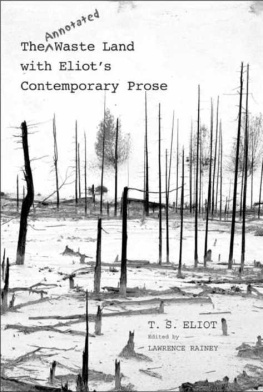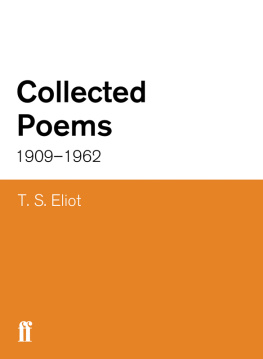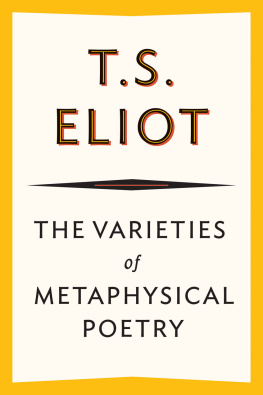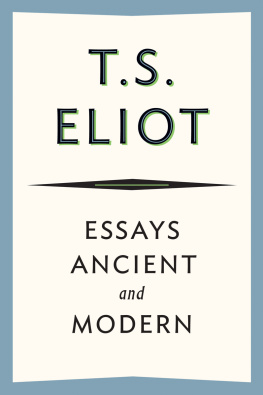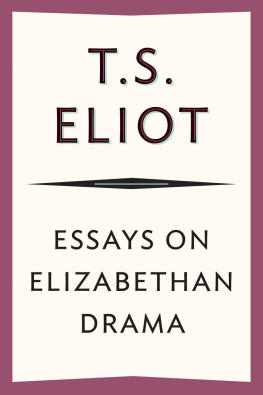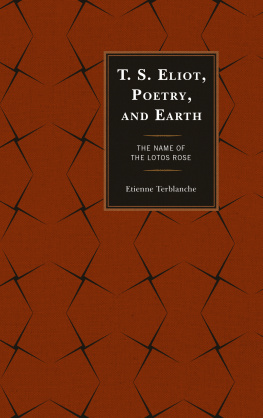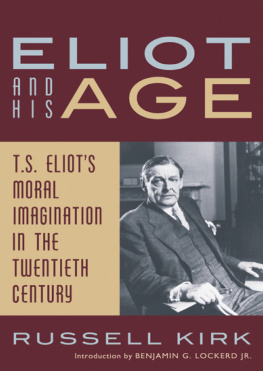T. S. Eliot - The Annotated Waste Land with Eliots Contemporary Prose: Second Edition
Here you can read online T. S. Eliot - The Annotated Waste Land with Eliots Contemporary Prose: Second Edition full text of the book (entire story) in english for free. Download pdf and epub, get meaning, cover and reviews about this ebook. year: 2009, genre: Detective and thriller. Description of the work, (preface) as well as reviews are available. Best literature library LitArk.com created for fans of good reading and offers a wide selection of genres:
Romance novel
Science fiction
Adventure
Detective
Science
History
Home and family
Prose
Art
Politics
Computer
Non-fiction
Religion
Business
Children
Humor
Choose a favorite category and find really read worthwhile books. Enjoy immersion in the world of imagination, feel the emotions of the characters or learn something new for yourself, make an fascinating discovery.
- Book:The Annotated Waste Land with Eliots Contemporary Prose: Second Edition
- Author:
- Genre:
- Year:2009
- Rating:5 / 5
- Favourites:Add to favourites
- Your mark:
- 100
- 1
- 2
- 3
- 4
- 5
The Annotated Waste Land with Eliots Contemporary Prose: Second Edition: summary, description and annotation
We offer to read an annotation, description, summary or preface (depends on what the author of the book "The Annotated Waste Land with Eliots Contemporary Prose: Second Edition" wrote himself). If you haven't found the necessary information about the book — write in the comments, we will try to find it.
The Annotated Waste Land with Eliots Contemporary Prose: Second Edition — read online for free the complete book (whole text) full work
Below is the text of the book, divided by pages. System saving the place of the last page read, allows you to conveniently read the book "The Annotated Waste Land with Eliots Contemporary Prose: Second Edition" online for free, without having to search again every time where you left off. Put a bookmark, and you can go to the page where you finished reading at any time.
Font size:
Interval:
Bookmark:

EDITED, WITH ANNOTATIONS AND INTRODUCTION, BY
LAWRENCE RAINEY
Second Edition
ELIOT'S CONTEMPORARY PROSE
Lawrence Rainey
W H EN DONALD HALL ARRIVED in London in September 1951, bearing an invitation to meet the most celebrated poet of his age, T. S. Eliot, he could only marvel at his strange good fortune. A young and aspiring American poet, he had earlier been an editor of Harvard University's celebrated literary magazine, the Advocate-as Eliot had once been-and more recently won a fellowship to Oxford-as Eliot had done, too, long ago, in 1914. Now he was going to meet the great man himself, the poet of his age, the man awarded the Nobel prize for literature in 1948. Hall was frankly terrified. His appointment was for three in the afternoon, but he turned up an hour early at the office of Eliot's employer, Faber and Faber, at 24 Russell Square, then decided to kill time by admiring the surrounding buildings. Finally, at three, he was duly escorted to Eliot's small office and greeted by Eliot himself, a person as diffident and distant as report had portrayed him. Their conversation went poorly. "I was so convinced of the monumentality of this moment-'I will be speaking of this, ages hence'-that I weighed every word as if my great-grandchildren were listening in, and I feared to let them down by speaking idiomatically, or by seeing the humor in anything." Eliot commented on some of Hall's poems, the hour passed swiftly, and by four it was time for Hall to leave. He leapt to his feet, sputtered ponderous thanks, and awaited Eliot's farewell:
Then Eliot appeared to search for the right phrase with which to send me off. He looked me in the eyes, and set off into a slow, meandering sentence. "Let me see," said T. S. Eliot, "forty years ago I went from Harvard to Oxford. Now you are going from Harvard to Oxford. What advice can I give you?" He paused delicately, shrewdly, while I waited with greed for the words which I would repeat for the rest of my life, the advice from elder to younger, setting me on the road of emulation. When he had ticked off the comedian's exact milliseconds of pause, he said, "Have you any long underwear?"
I told him that I had not, and paused to buy some on my dazzled walk back to the hotel. I suppose it was six months before I woke up enough to laugh.'
The reader who comes to Eliot's masterpiece for the first time faces much the same dilemma as Hall did. The poem is preceded by its reputation, endowed with authority so monumental that a reader is tempted to overlook the poem itself, to slight its grisly comedy or miss its mordant and ferocious wit, its dazzling series of surprises, its sheer wildness and irredeemable opacity. While Eliot's status as an international celebrity has plainly waned since his death in 1965-what other poet could give a lecture in a basketball arena holding fourteen thousand spectators, as Eliot did in 1956?-his most important poem still retains its lacerating power to startle and disturb.
ELIOT'S CAREER BEFORE THE WASTE LAND
Thomas Stearns Eliot was born in St. Louis, Missouri, on 26 September 1888, the last of six children. He had four sisters, the oldest of whom was nineteen years his senior, and one brother, Henry, who was nine years older. His mother and father were already in their forties by the time Eliot was born. His father, Henry Ware Eliot, was a successful businessman and president of the Hydraulic-Press Brick Company. But Eliot seems never to have been very close to him. Instead it was to his mother, Charlotte, that Eliot was drawn. Proud of her intelligence, she had not been able to attend university and instead had earned her living as a teacher until she met her husband. She had also written poetry. Her thwarted ambitions were transferred to her son, who was nurtured to become a scholar, perhaps even a poet. From what little can be discerned, Eliot was a shy and bookish boy, one who felt somewhat out of place wherever he was. His family maintained a strong sense of its origins in New England-his grandfather had moved from there to St. Louis in 1834-a sense which made him feel out of place in the South. But he was no less aware of his Missouri drawl when the family took its annual vacation in Gloucester, Massachusetts.' He was also isolated by a physical handicap, a congenital double hernia, which meant he had to wear a truss for most of his life and could not participate in sports. Eliot later recalled that his family had "lived on in a neighborhood which had become shabby to a degree approaching sluminess, after all our friends and acquaintances had moved further west."3 The area was being taken over by poor African Americans, and Eliot's lifelong appreciation of popular song and his responsiveness to the seedy side of urban life owed something to this background.4
When he was seven or eight, Eliot began to attend a local private school. In the autumn of 1898 he began to attend Smith Academy, a preparatory school for Washington University, a prestigious university in St. Louis, which Eliot's grandfather had helped found. By January 1899, he already had brought out eight issues of his own magazine, the Fireside, a childish production that featured adventure stories, rhyming verses, and puns. Though he finished Smith Academy in 1905, his mother decided to wait a year before sending him to Harvard, a year he spent at Milton Academy, a private school outside Boston. There he met Scofield Thayer, a wealthy young man who later became co-owner and leading editor of the Dial, the journal in which The Waste Land was first published in the United States.
In the autumn of 19o6 Eliot began his undergraduate studies at Harvard. In his second year he decided to complete his course for a bachelor's degree in three years rather than the conventional four. His courses covered a wide range of topics: German grammar, constitutional government, Greek literature, medieval history, English literature, French literature, ancient philosophy, modern philosophy, and comparative literature. But much that Eliot wanted to learn could not be discovered in the classroom. He was actively reading on his own. He later recalled the Scottish poet John Davidson (1857-igo8), and especially his poem "Thirty Bob a Week," with its stark presentation of a city clerk. He had "found inspiration in the content of the poem," Eliot later recalled, "and in the complete fitness of content and idiom: for I also had a good many dingy urban images to reveal."' More important, however, was his discovery of Arthur Symons, whose study of The Symbolist Movement in Literature he purchased in December 19o8. The book was "one of those which have affected the course of my life," he said many years .6 Above all it led Eliot to the discovery of the French poet Jules Laforgue (i86o-1887), the author who was "the first to teach me how to speak, to teach me the poetic possibilities of my own idiom of speech."' Eliot promptly ordered the three volumes of Laforgue's Oeuvres completes, which reached him in the spring of 1909. In Laforgue's poetry Eliot found much that he could adapt to his own use: the couplets turned by neat rhymes, the counterpoint achieved by interweaving stanzas with different imaginative weight and line length, and a tone that was questioning, quizzical, ironical, inconclusive. Within months the poems which Eliot was publishing in the Harvard Advocate were plainly showing the influence of Laforgue, even announcing it in their titles: "Nocturne" in November igo9, "Humouresque (after J. Laforgue)" and "Spleen" in January igio. But influence should not be taken to imply passive imitation. "People are only influenced in the direction in which they want to go," Eliot wrote much later, "and influence consists largely in making them conscious of their wishes to proceed in that direction."8 But what was the direction in which Eliot wanted to go? Conrad Aiken, whom Eliot met in the academic year igo9-19zo, when he stayed on at Harvard for an extra year to study for an M.A., later recalled their conversations: "What did we talk about? or what didn't we? It was the first `great' era of the comic strip, of Krazy Kat, and Mutt and Jeff, and Rube Goldberg's inspired lunacies: it was also perhaps the most creative period of American slang, and in both these departments of invention he took enormous pleasure."9 Eliot's interest in `American slang" and "the comic strip," his openness to vernacular culture, may go a long way toward explaining why even the poems which most directly evince the influence of Laforgue possess a colloquial vigor that sets them apart.
Font size:
Interval:
Bookmark:
Similar books «The Annotated Waste Land with Eliots Contemporary Prose: Second Edition»
Look at similar books to The Annotated Waste Land with Eliots Contemporary Prose: Second Edition. We have selected literature similar in name and meaning in the hope of providing readers with more options to find new, interesting, not yet read works.
Discussion, reviews of the book The Annotated Waste Land with Eliots Contemporary Prose: Second Edition and just readers' own opinions. Leave your comments, write what you think about the work, its meaning or the main characters. Specify what exactly you liked and what you didn't like, and why you think so.

